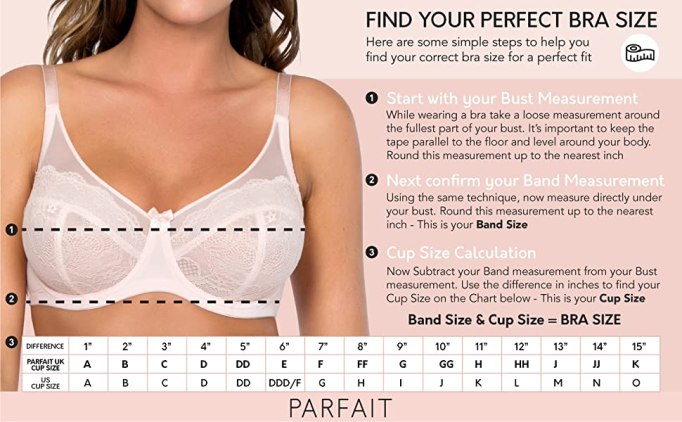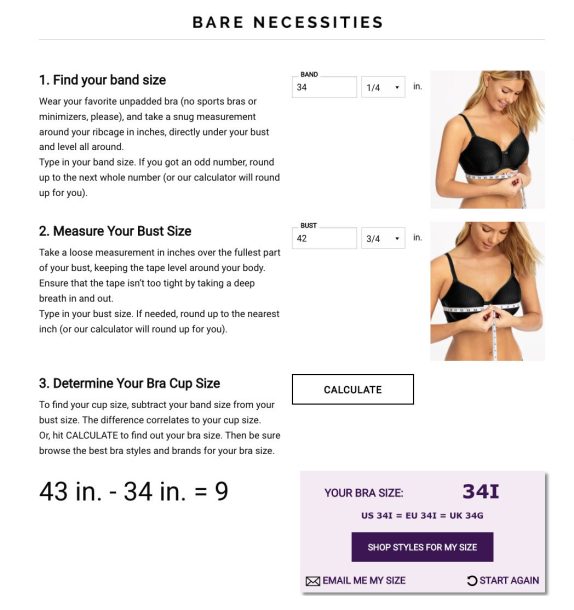Welcome, folks, to one of the most important entries in this blog. I’m about to tell you something that a lot of bra wearers do not know. It’s a simple fact, but nevertheless, it’s a concept that can be difficult to fully accept.
Bra sizing is not consistent. Universal size standards for bras do not exist.
What I mean is this: you know the situation where you wear one jeans size in a certain brand but a different size in another brand of jeans? Bras are no better. On the whole, women’s clothing sizing is terribly inconsistent. Personally, two of my favorite dresses are labeled as a Medium and a 3XL, respectively. They both fit me. People really, really want to believe that bra sizing is different. Those sizes on the label have some concrete reliable meaning, right? I’m so sorry to be the bearer of bad news. They do not.

A lot of people don’t want to believe this. It runs at odds with what they’ve been told their whole lives about how bra sizes work. Some individuals are actually really attached their “bra size” as part of their identity. It’s true, though. Look for a standardized bra sizing specification list online. I don’t mean a size chart for a particular brand or instructions for sizing yourself. Rather, what is the universal length of the band on a bra sized, say, 40D? Or the cup volume of a 36B, for example? This list of universal specifications doesn’t exist… because there’s no such thing as universal size standards that bra makers agree on. Every brand is using their own proprietary size scale.
You know what does exist? Bratabase, an entire website dedicated to crowdsourcing the collection of specific measurements for individual bra styles and sizes in an attempt to gain some understanding of how sizing runs in that specific bra. Bratabase’s entire premise is an attestation to the fact that every single bra fits differently.
There are many ways to illustrate this point. In our boutique, we have educational displays to help customers understand sizing inconsistency and why we might bring them different sizes in different bra styles, which we do all the time. We have actual physical examples of same label/ different volume bra cups:

We can lay out bra bands side-by-side, as we did in the featured image at the top of this article. We also did an experiment where we used beads to measure the cup capacity of different bras with the same size on the label:

You’ll notice, none of these things match exactly. Some of them are actually quite different; it’s easily enough variation to require a different label size for an optimal fit. At Grail, one of our training tools for fitters is an enormous guide to the sizing details, fit characteristics, and rules-of-thumb for sizing up or sizing down on every bra style we carry. If our staff didn’t need to know which bras fit larger or smaller than “baseline” (which is a more accurate and useful way to think about it, rather than “true-to-size,”) I assure you that I wouldn’t be taking the time to create a 120-page compendium of bra quirks.

But wait, you may be wondering, haven’t you posted repeatedly about how to determine your bra size? If that doesn’t work, what gives? Using body measurements to determine a bra size does work… as a starting point. As we’re always repeating, measurements alone are hugely helpful for getting in the ballpark of your baseline size. What measurements do not account for is (1) body shape and variations in volume distribution- expect your bust measurement to under-represent your actual breast volume as often as not- and (2) inconsistency in sizing on the garment side of the equation. Your Bra Size, insofar as it exists, is what we’d treat as your average size at Grail. It’s the middle-of-the-road, the size we’ll go up or down from for bra styles that run larger or smaller. If you’re shopping on your own, it’s the size you try first, understanding that you may have to size up or down depending on how that bra actually fits you.
What about size charts? In most cases, using a sizing chart for a particular bra maker is probably a bit more reliable than going off a bra size label alone. However, it’s still not that straightforward, and your mileage will probably vary a lot. I have never seen a brand offer different size charts for different styles, and I have also never once worked with a brand which had a consistent fit across their bra styles. For example, most Natori bras tend to fit large in the band and small in the cups. However, their Conform Contour fits big all over, and Cherry Blossom high apex has a band that runs tight. Older Parfait brand bras run tight in the band, but their newer styles do not. Wacoal bra sizing is all over the map from style to style. (Wacoal is happy to offer you a virtual fitting using some new digital tools, but their algorithm gives you one size for their entire product line. I have no earthly idea how this is supposed to result in good customer outcomes with so much variability in their products.)
Actually, size charts are another great way to illustrate this inconsistency principal. Some brands, at least in theory, size based off of the modern system of bust/ under-bust ratios:

Other brands completely throw that out the window and do their own thing with sizing, unrelated to anyone or anything else:

You see the same thing when you’re trying to determine sizes on internet bra shopping sites. Entering the same body measurements on the Bare Necessities site and the Playtex site will result in very different sizing recommendations.


Speaking of online bra stores, how do they factor into this? If there really is no consistency in bra sizing and those size labels are sketchy at best, how is bra shopping online supposed to work? Honestly, it doesn’t work especially well. The return rate for bras bought online is 40%. That’s a seriously huge number of bras! It’s the biggest reason why Grail doesn’t have an e-commerce store: too much fuss, time and hassle processing returns, plus a lot of frustrated customers. Even those bras purchased online that weren’t returned may not necessarily fit well. Maybe they just weren’t bad enough for the buyer to bother trying again, or maybe the items were non-returnable. It’s a pretty terrible system for customer satisfaction.
Some online retailers are honest about this fact.

Other online shopping sites, not so much. The truth undermines confidence in their business model, which is built on the fiction that bra shopping online is simple and convenient. Sizing inconsistency (in addition to other factors like the shape elements of bra fit) means that buying a bra without trying it on first will always be a roll of the dice. It really bothers me that a major e-commerce site for lingerie will, for example, spend an entire article low-key gaslighting you that if a bra in Your True Size doesn’t fit, it must be because you don’t know how to dress yourself:

Yet, in comments and reviews on their listings, they’ll begrudgingly admit that maybe uniform sizing isn’t a thing after all:



It’s annoying because it’s disingenuous. They know better. They’re the ones processing those 40% returned bras, after all.
As a final note, some folks on social media have taken issue with our characterization of people not having a “True/ Correct/ Real Bra Size.” They maintain that if you calculate your size using what they deem to be the proper method, the resulting bra size is in fact your True Size. “It’s just that all those [whatever sized] bras that don’t fit are ‘not true to size.'” This is kind of a silly distinction as far as I’m concerned, but if you would prefer to look at it from this perspective, that’s your prerogative. It still doesn’t change the fact that there are no universally adopted size standards for bras. What is or isn’t “true to size” is therefore subjective and a matter of deviations from the average, not deviations from anything standardized. I would love to live in a world with established size standards! Maybe one day, representatives from the various bra makers of the world will all come together and agree on universal sizing specifications. I wouldn’t count on it, though. (If that did happen, however, maybe we could fix the rest of women’s clothing sizes while we’re at it!)
If you’re wondering where this leaves things with respect to finding a well-fitting bra, it’s the same scenario as it has always been. You must try bras on to know for certain whether they will fit. Truly! 😅





0 Comments